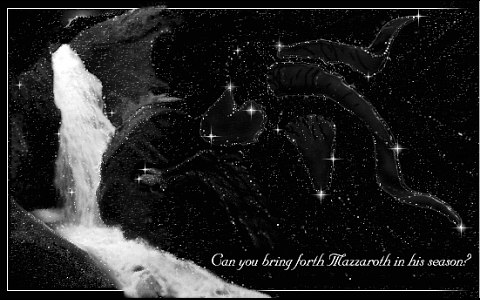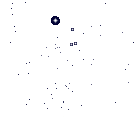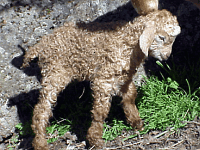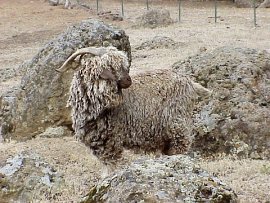
Freshly shorn - sun, air, exercise and vibrant spring pastures revitalize and rejuvenate the herd after Winter's Fleece. A picture taken eons ago, it seems. A lot more color in the herd these days and much less 'white'...
It's a BAND of goats. It's a FLOCK of sheep and a HERD of cattle. But in contemporary USA that convention is rapidly going away. It is very common to hear the term herd applied to a band of goats. So for the sake of sanity we'll go with the flow
Cultivation of the earth is a most ancient occupation of man. Running concurrently with this basic method of survival has been the cultivation and domestication of the animal kingdom. Civilization depends on nature to sustain it for food, clothing and shelter. Domestication was the product of seeking greater efficiency with regard to meeting the basic needs of life. It has run amok. Our effort is essentially a backtracking to find the balance of a functional sustainability.
Here in western society the link between us and the fundamental components essential to living have been obscured by lifestyles that are alienated from the rigors imposed by nature. Our efforts to become efficient at acquiring food and shelter composed mainly of elements that distance us from nature and compact us in heavily population urban areas. Modern America seems unaware of where their food comes from. The clothing they wear, the blankets on their beds, the coats they snuggle into on cold winter days, if made from natural fiber, begins in the animal kingdom. As far as food, in many cases there has been the chemical preservation of much of the food supply. Most don't realize the detrimental side effects that attend these treatments or are too busy to care. By and large there is a great physical, psychological, economic and cultural gap between us and the fundamental resources of nature that sustain us. The principles of nature that once directly molded much of our world view and behavior are distanced from us.
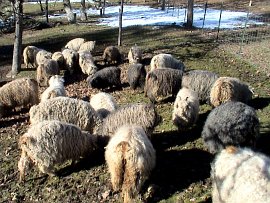
The does in full fleece
Farmin'
Periodically there have been stirrings within western society that have stimulated our interest to get "back to the land" and " back to nature."The individuals participating in these movements instinctively sense the security and benefits of touching back into the ancient and profound legacy of humanity's place in the larger scheme of nature. In western culture that is not altogether an easy task. There is a great breech in the societal continuity. Land is becoming more and more of a premium. The oral and cultural traditions that have faithfully transmitted the knowledge and skill sets that enable us to live closer to the land have been replaced by a fast paced exponentially expanding body of ideas often derived from a context outside of nature. The social structures of family and community that were the "hands on training grounds" for life in rural society no longer exist in most places.
Many of those who would return to the land and set down roots within a sustainable symbiosis of their surroundings are often a more mature age group. The resilience and ability to adapt found in youth has often already been spent attempting to survive mega-city urban cultures. Instead of growing up with the rigors of learning by doing, most of us who return to the land are motivated by dreaming. There is a lot of catching up to do with respect to the ways of life and nature. Many indigenous sources of vital ecological and practical information have passed away generations ago. The old timers are gone and they have taken the knowledge and wisdom associated with their unique experiences in their particular part of the world with them.
Also, our environment has been heavily impacted by the technological advances of the industrial revolution. So much so that some of the old rules no longer apply. We must find a new way in such instances.
Consider the issue of property acquisition and ownership. Most of the richest bottom land in the contingent USA is presently the place of huge cities and super highways. Flat riverfront land and fertile valleys are the easiest to build on. It is also the repository of ancient waves of nutrition released by the rhythms of nature. Floods of rich silts built these geographic zones in the first place and now they are covered with asphalt. The greater portion of affordable land accessible to the modern homesteader is "marginal" land from an agricultural stand point.
Also, we are left with cultivating wilderness so as not to destroy what remains of those geographic locations that support what is left of wildlife. The search is for just the right amount of "bottom land" to sustain us. And just the right amount of wilderness to maintain so that some of the processes of nature that built up the land in the first place continue.
Silver Linings
There are silver linings in the clouds. One of the big advantages of swift modern communication is that we can compensate to a degree for our lack of rural living knowledge. A short jaunt on the internet will often give us access to critically needed information that helps us manage a problem in a broad range of homestead issues. We are able to share our discoveries and experiences with unprecedented speed. A cyber community exists that can share knowledge with the versatility of the internet and even lend emotional/social support in the trials of our experiments. A new momentum of discovery can easily be created that allows us to sift through what remains of what is known and what we need to know to live sustainably.
Another advantage we have is hind sight. The industrial revolution and the post WW II mantra of "better life through chemistry" have left an inexorable mark of destruction on the rural and wilderness landscape. These are the very last refugia for the would be modern pioneer. The mistakes made by those who would wrestle nature through brute force to satiate their desire for monetary gain are apparent to anyone who has lived in the out back for any length of time.
The land, streams and forests, with all their complex and intricate ecological depth, were handled like the tonsils and bladders of post war Americana Materia Medica. If you don't know what it does and it is giving you a hard time, eliminate it. Cut it out and be done with it.
So now, many species that once abounded and were integral components of forest and stream health are gone. The rural and wilds languish with the vacuum left by these missing keystone species. Beavers and porcupines are specific examples that illustrate my point. The collapse of salmon runs and the over population of second and third growth stands of trees are the end result. Some of the conditions left in the wilds can be mitigated but many cannot. As people of "place" we feel obligated to do what we can when we can toward the work of reparation.
Farmin' Ain't Easy
After three decades of gardening and animal husbandry we are still sure we've made the correct decision to go back to the land in spite of the many challenges. Ours is a task of cultivating domestic life with a wilderness interface. The world in which we abide constrains us to also cultivate and maintain wilderness in close proximity to us. It is an extra burden. Nature often clashes with domestication. But time has passed and we are relatively comfortable about our responsibility to keep the creatures who sustain us, and who we sustain, happy and healthy. What countless generations of the past took for granted as the drudgery of every day life we jealously guard as hard earned treasures of experience and understanding.
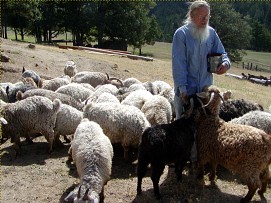
Symbiosis at Singing Falls
It has all left a deep mark on our character. The challenges at times seem overwhelming. But in the Autumn of our lives our blessings seem innumerable. The richness of many of the treasures of nature, the things we have seen and done, the trials we have endured, the unspeakable depth of beauty we have touched, can never be taken from us. They are written upon the history book of our souls. We have been true. Though often poor, our riches are priceless. We have immersed ourselves in depths of life and affirmed our place in the truth.
Here is an example. Consider the rudimentary task of modern day shopping. If you are a carnivore, you stroll to the meat department with cart in tow. Carefully you examine the cuts of fish, fowl, red meat that are available (along with the size of your bank account). You make your selection and slap your neatly cellophane wrapped styrofoam package into the cart and go. Little thought is paid as to what it took for you to supply your need outside of the pain of watching the price rise regularly and the effort it took for you to accumulate the sum.
What of the living creature that died so that you could live? Where did it come from? What was its manner of life? Few know. Not even the butcher in most cases. And fewer still have a conscious connection with the price that has been paid to sustain their busy lives.
Close But Not Too Close
This brings us to a more delicate issue. It has to do with respect for life and the reduction of the size of the herd. Each year decisions are made to reduce the herd population. They multiply and we cannot keep them all. If we did retain the entire population, the entire herd would suffer unless the land base that sustains them is increased. In the wild, dispersal, disease and predation are the mechanisms that keep animal populations down. In the herd there is an awareness of these dynamics that we have observed. Socially the band will begin to harass the weaker individuals to further weaken them or drive them away. It is something we are constantly on guard for. We are particularly interested in having docile characteristics in herd behavior. This in turn makes the main individuals with these personality virtues particularly vulnerable to the more aggressive members of the herd. In its natural setting the herd makes choices of who stays and who goes when the base of sustenance diminishes. Drought, geography, and a complex array of elements that support life in a given area play a part in the population dynamics of the herd. Health and strength are profound determining factors. If you are weak, you die very soon.
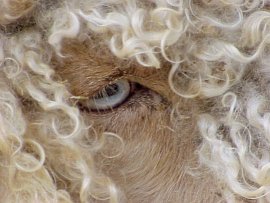
Capricious Blue Eyes
The ancients understood many of these principles by studying nature. They began to scale down the size of their domestic livestock and wildlife herds for their health. We resort to the ancient practice of deriving sustenance from the domestic herd as they did. Each year animals we have long been acquainted with are selected for our own food supply. To date this has never been a mundane or routine task.
One thing is certain. Every aspect of this part of our lives is attended with a solemn respect and sobriety. Every individual of our band and flock is intimately known. Daily their health and happiness is evaluated. We care for them. They are not a mere commodity or food supply to us. They are a part of our lives. Considerable portions of our time and resources are used to keep them well fed and comfortable. They must have a sense of genuine well-being to be well. Many long hours and days and nights have been used up doctoring a sick animal. It is not purely an economically based decision. Resources do play a large role in decision making but so does our sense of responsibility toward the individuals in the flock.
Every year we have purposely allowed ourselves to be exposed to the real cost of living. Every aspect of what it means to live off the land and from our herds is weighty. What is it like to take the life of another living being so that we can live? The price is high and tangible when butchering season arrives. In our effort to succeed, we seek to emulate what nature would do. Decisions are also influenced by our breeding program. A mistake can impact the herd for years to come. We earnestly pray and seek wisdom in this effort. Respect for life is the end result. Nothing goes to waste. Hooves and horns, skin and meat, they all have a rightful place after the life of the creature is spent. The practice keeps us well aware of what it means to be sustained. This reality is rife throughout the wilderness. Everything leans and depends on everything else. Ungulates (deer and elk) devour vegetation. The lions consume the deer. The foxes, skunks and coyotes finish the remains. To a degree we mimic what we see and live.
This aspect of our lifestyle has ingrained in us a profound deep
sense of the value of life in all of its forms. No blood lust
surrounds our task. Only the certain desire to return the soul
inhabiting the body back to a place of rest with God. Much prayer
and gratitude is expressed for the gift of life. The true and
essential meaning of sacrifice is burned into our very hearts and
minds, again and again. Through it we learn to give and receive. We
see that our continual care during the year is part of our debt. It
expands the depth of commitment that we know is required of us
spiritually and in all respects. Through it we have learned to live
in the true context of what it means to walk the earth in these
times. The meat department at the local store cannot give you
that. If the herd dies, we die. If we live, the herd lives.
Judgment calls are always being made in our struggle to adapt our living circumstances to changing conditions. Sometimes we compromise long held policies for the sake of improving conditions among the livestock. The arena of using synthetic chemicals for the treatment of parasites is a good example. When possible we use herbal treatments. When push comes to shove we figure a chemically treated goat is better than a dead one. We may be wrong.
What will be the impact on the herd with the use of synthetic chemical compounds, compounds that most likely have never been in contact with the animals gene pool since it was formed? Will there be genetic problems appearing down the line in future generations? So far no. But time will tell. What of the immediate impact on our food supply? We do not treat animals destined for soon consumption. Chemical treatments are expensive. Perhaps in ways beyond the mere monetary outlay that are not yet surfacing. On the other hand, the stress levels of the angoras and sheep diminish radically after treatment for internal or external parasites. For this we are grateful and so are they.
Losses and Gains
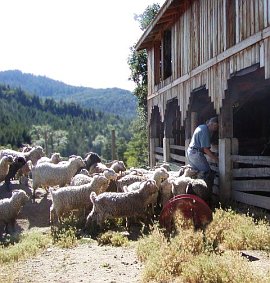
Protection from the Creatures of the Night
We've had a lot of set backs, heart aches that only a shepherd would understand. Predators, parasites and forces of nature have caused sometimes severe losses. A time or two we have lost the "cream of the crop" as it were, a forerunner in the herd as far as being an outstanding herd sire or potential breeding doe with excellent traits. We have taken the losses and "rolled with the punches" and have continued to do the best we can to make this essential component to our lives meaningfully healthy.
When the blessings of the spring rains and sunshine increase the verdant growth of the fields, the goats rejoice. They browse voraciously on the new growth, whether it be poison oak, blackberries, grasses or forbes (which bolt up during this time of year.) We have spread by hand strains of clover, grasses and plant species particularly suited for our area for their enjoyment.
After the long winter clip of mohair is removed and hoof trimming is done the fresh air and sunshine bring the health of the herd to a wonderful peak. The toll winter has taken on the herd seems to vanish in such a short while. The ground which has been overly wet and which can cause hoof problems in the goats, begins to dry out. Everything is lush, and the goats do not graze far afield, for in a short time they are well filled. It's our favorite time of the year, as shepherds, and seems to be the goats' favorite time of year also.
The rich tips of browse can reach protein levels of up to 25%. All that protein intake seems to burst forth in fleece brilliance and character. The romping and rambunctious kids receive fresh rich milk continually. To see them frolic and bounce on the run is so invigorating and inspiring. Each burst of youthful energy so personifies life unencumbered by the stark realities of the dangers that surround it. The morale of the herd blooms just as the field and forest do. Mohair fleece, which requires high protein intake for optimum growth, begins to lengthen visibly and lushly on the animals, a token to us, the shepherds, of promise for the future.
Herd pictures are various shots of our band just before shearing. The long winter fleece has been washed by sun, wind and rain. Mohair's strength is very apparent at mohair harvest time. The dark hues of color and brilliance of the white is revealed beneath the bleached "tips" of the hair (most noticeable on the outside of the unsheared animal.) Once the goat is sheared, and the fleece laid out, the fleece unexposed to the harsh elements of sunshine and weather is much darker and the variation in natural hues found in the herd are incredible.
When one considers natural fiber for clothing, the most poignant element has to be the obvious rightness of its use to insulate us from the harsh elements of wind and cold. Mohair, from the angora goat (as opposed to "wool" from sheep) is warmer, stronger and more lustrous than most wools. Kid mohair is of such fineness as to defy our sensibilities of what nature can produce. Many have compared kid hair to angora rabbit hair (known in the fiber world as "angora", not to be confused with angora goat hair, kid or otherwise, which is always "mohair.")
Since we have always mainly been "mountain dwellers" during our earthly sojourn, we have oft marveled at the capacity of nature to produce tender foliage and delicate flowers after the ferocity of winter with its howling northern winds and heavy blankets of snow and ice. It reminds us continually of the mystery that surrounds our goats. How can so bright and beautiful a fiber be produced from the raw substance of forest and meadow that these goats thrive on? The answer is seen in their exquisite mohair. The answer challenges our understanding. Mohair comes from a living creature; the fiber is not synthesized in a factory.
On this farm we raise quite a few angora goats with the traditional white fleece. Initially when we began shepherding the angoras in Montana some time in the early 1980's, our small herd was entirely white. The colored angora goat registry really didn't become official until 2000. We had one colored doeling in that first Montana group that most goat raisers at the time would have considered "cull material." She was a distinctly blue hued goat with dark horns and hooves. Since our herd was of purebred stock, her coloration was rare (and at the time not sought after.) Stanley loved her at first sight and knew instinctively, perhaps, that she was a jewel in the midst of the herd. She was our first contact with what we came to know later on as the "colored" angora goat. Unfortunately we do not have a picture of Mildew (that was her given name.)
COLOR! COLOR! COLOR!
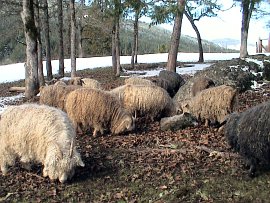
Treat time at Singing Falls
We love natural colored mohair in our herd. When this breed was developed back in the Persian Empire, the colored gene was selectively removed to accommodate dyes.Modern Angora goat breeders, up until very recently, destroyed every colored goat in their herds. Now there is a great interest in natural colored fibers and with that trend has come an exciting time of experimentation and growth. We have been breeding with color in our herd for some years now and each spring produces more of the colorful splendor that nature produces in this valuable fiber. The breeding process is slow but rewarding. Individual fleeces are for sale to the hobbyist, artist, and various other crafters. Primarily a spinning fiber, our mohair is also used for doll hair. It is strong and fire resistant. We have color and white with color factor kids for sale each year.
Try to catch these creatures by walking up to them and snatching one. You'll get plenty of exercise! Walk into one of these paddocks and all eyes will be on your hands. If you're holding anything in your hand the herd comes running. The "fear" they pretend to have of you melts away at the prospect of a handful of grain for a treat! The above shot is of such a moment.
Having romanticized notions of raising some of your own livestock? Think hard about it. Once you enter into this symbiotic relationship you're in on an everyday commitment. Alexandra and I have long given up the idea of ever having a "vacation". But then, where would we go if we ever did manage one? But for a few other special places in this world, we are where we would be. Still and all, like all things in this life, it has its mountains and valleys, its deep sorrows and great joys. To have our feet firmly planted on the earth and our heads totally integrated in heaven is our aim.
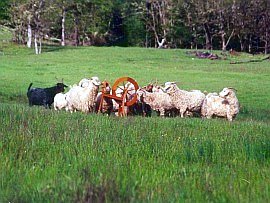
"She does what with this thing and our hair!?"
This is not exactly what we had in mind for a spinners flock! "Spinning lessons anyone?" or, "She does what with this thing and our hair?" We have received many emails and comments with regard to this picture. It is a classic display of the capricious and inquisitive nature of the angora goat.. You'll find more information regarding our present herd at the links to the buck, doe and kid pages below. Please take the time to look if only for purely academic reasons and curiosity. All things in nature have something to teach us.
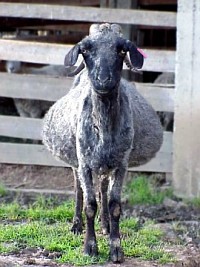
"Honey, does this eartag make me look fat?"
Here on the right we have a doe named "Martha Martha". She is one of our old does sporting the latest in "twin wear" here at Singing Falls a few seasons back. She had freshly been shorn of her locks and is almost ready to give birth to her kids. She was a good doe with strong mothering instincts, a quality we especially seek in the does of the herd. Often we have seen such traits ignored in favor of mohair quality. Herds made up of such animals will not survive long if placed on the open range. Domestication has its serious implications in that regard.
Bucks of Singing Falls
Does of the Umpqua Goat Band
Kids of Many Colors
